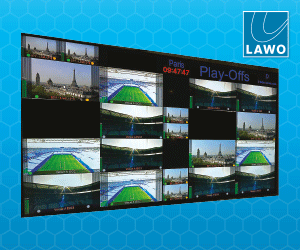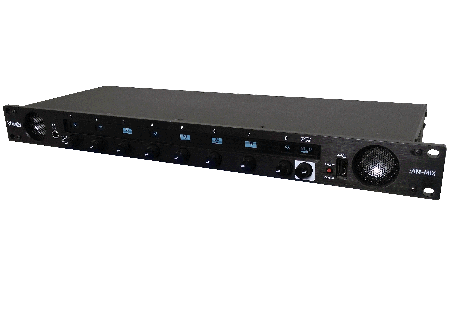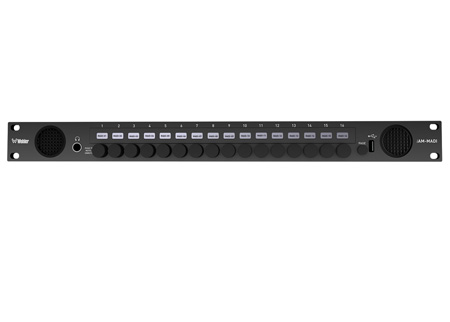File-based automation offers a flexible platform for complex broadcast challenges. Craig Newbury advises broadcasters in the region to use file-based automation to manage one or many key processes easily through a single interface Broadcasters in the Middle East face many challenges typical to an expanding and evolving marketplace. In day-to-day operations, broadcasters are expected to […]
File-based automation offers a flexible platform for complex broadcast challenges. Craig Newbury advises broadcasters in the region to use file-based automation to manage one or many key processes easily through a single interface
Broadcasters in the Middle East face many challenges typical to an expanding and evolving marketplace. In day-to-day operations, broadcasters are expected to solve workflow issues such as ensuring loudness compliance or legalising video.
For some facilities looking at their end-to-end workflows, establishing more efficient SD/HD conversion and standards conversion of international broadcast content for domestic distribution is critical to a profitable business model and competitive programme offering. Taking on even larger projects, other facilities are working to plan and implement a smart, cost-effective migration to HD or a smooth transition to file-based operations.
File-based automation technology offers broadcasters straightforward, scalable solutions for addressing specific issues within the workflow and for overcoming larger technical and infrastructural challenges. Rather than spend time and money attempting to integrate dedicated hardware and software systems, with their many varied disparate workflow and integration challenges, from multiple vendors into a cohesive system they can manage effectively, broadcasters can use file-based automation to manage one or many key processes easily through a single interface.
Solving specific workflow problems
Built as a service-oriented architecture, the file-based automation platform turns tasks such as user and asset management, ingest, encoding, and delivery into reusable services. Applications, which are layered on top of the services to offer functionality to users, can be as broad or narrow as desired, and they can integrate any or all available services.
In this way, file-based automation offers broadcasters a toolbox of solutions for specific applications and problems. The platform can handle tasks such as loudness correction, standards conversion, and media management and subsequently, expand to include additional processes, according to the broadcasters requirements. All this allows broadcasters to take full advantage of the media they own, create, or acquire.
Loudness correction
Ensuring loudness compliance is a common problem that is increasingly being addressed through file-based automation. File-based loudness inspection and correction offers a fast, efficient method of solving loudness problems and maintaining compliance with global loudness standards. With this solution, users can identify and correct loudness issues at ingest, before they become a problem. In handling the audio associated with video, the platform can leverage trans-wrapping functionality to enable rapid audio processing, without the need to decode and re-encode video files and without compromising the quality of the original content.
Video legalisation
Full broadcast gamut colour legalisation is another challenge addressed by file-based automation platforms, both independently and as part of a larger processing workflow. The ability to legalise gamut for broadcast within the NTSC and PAL domains in a file-based workflow ensures that content passing through the broadcast chain will meet on-air quality requirements. More important for many broadcasters, it eliminates reliance on baseband processing systems and the need to break out of the file-based domain and away from the continuity and efficiency it enables.
Gamut legalisation options, one of the detect and correct capabilities available in some file-based automation platforms, assure that any input into the processing pipeline can be legalised for broadcast upon output. Providing users with options, such as RGB only, RGB + Y (enabling EBU R103-2000 and DPP compliance), composite (NTSC and PAL) domain, and other combinations, the platform automatically fixes content and yields an output suitable for broadcast.
SD to HD conversion
Consumers rising expectations include not only more flexible access to media, but also the availability of content at higher resolutions. As broadcasters respond, shifting to HD and offering premium high-resolution services, quality is a key competitive differentiator. However, maintaining or even enhancing the quality of audio and video cannot compromise the speed with which content is delivered. In fact, as demand increases especially for nonlinear services such as OTT and VOD the ability to deliver content even more quickly while maintaining the highest quality standard becomes increasingly critical.
Automated file-based conversion of SD content to HD gives broadcasters the means to leverage the content they have to offer a more valuable service and to do so with a relatively small technology investment. As part of a larger workflow guided by file-based automation, conversion helps open the door to new opportunities. As the marketplace continues to evolve, file-based automation positions broadcasters to consider production and/or delivery of 2K and 4K content as consumer demand and their business models dictate.
Frame rate and standards conversion
When a file-based automation platform unites grid-enabled CPU-based processing technology with GPU-based image processing techniques, it can facilitate faster-than-real-time processing of content without compromising its visual quality. This powerful combination is critical for rapid file-based standards conversion within a transcoding workflow.
In this application, incoming content can be captured in a watch folder and sent for decoding and transcoding across multiple nodes in the grid-based server farm completely automatically. Processing of audio and ancillary data is handled in parallel. Multiple servers running powerful GPU cards can enable frame-by-frame conversion by addressing different parts of the source video in parallel and stitching them together as a whole converted product, complete with audio and ancillary data, ready for distribution. The use of GPU-based algorithms ensures the quality of the converted output. Temporal and spatial image resampling supports the conversion of source video and image files to any new frame rate or resolution. When a motion compensated engine is used to generate accurate motion vector data, the platform can interpolate new frames for any desired delivery specification or standard.
Among the operations that may be stacked into this file-based conversion process are resolution scaling (mobile device to 4K); frame-rate conversion (any to any); standards conversion (525, 625, 720, 1080, 2K, 4K); interlaced, progressive, and pulldown interchange; automatic cadence correction; mixed pulldown (60i + 24p) with broken-pulldown pattern repair; accurate motion blur modelling; and timecode preservation (drop frame/non-drop frame).
This new approach to standards conversion and other critical processing tasks offers the industry a particularly compelling reason to transition from baseband to file-based workflows.
End-to-end workflow
File-based automation can interface with a wide variety of solutions and manage their functionality to achieve both the users workflow goals and to enable simpler management of the overall workflow. Users can simply define the workflow they wish to execute, and the platform constructs an optimised set of jobs that execute their workflow. As a result, the user can accomplish much more in an elegant, high-performance, and less human-resource-intensive model.
To resolve the complicated problems surrounding content preparation, parallelisation of media processing and transformation, content management, and content packaging and publishing, file-based automation orchestrates the processes involved in media production and delivery and uses best-of-breed technologies to perform those processes. When such a solution integrates with and augments traffic, rights management, linear automation, and business process management systems, it is capable of addressing the entire broadcast workflow.
Within this new workflow model, technology dependencies are compressed into a parallel platform architecture and the workflow itself is guided by predetermined policies and/or on-demand actions. Grid-enabled CPU-based processing technology provides powerful and flexible support for processing tasks. In this way, the automation system can assure high asset quality while facilitating one or many content transformations in batch or grid approaches.
The file-based automation model has clear benefits for large broadcasters with many channels, but it is an equally compelling solution for smaller broadcasters or even departments within larger organisations. While large facilities can use this approach to scale out more widely and quickly, smaller organisations gain from implementing an all-in-one solution that meets the majority of their needs, without requiring extensive sourcing or work with multiple vendors.
Moving forward
Many broadcasters want to plan ahead in their workflow implementation, but simply dont have the infrastructure in place to do so. Offering a more intelligent and more scalable set of tools for media transformation, a file-based automation platform can help these broadcasters to realise more advanced workflows with less infrastructure. Greater intelligence helps users to minimise the need for user intervention, and system scalability allows the user to grow the system with speed and ease and in line with budgetary constraints. Consequently, broadcasters that adopt file-based automation gain the ability to move into new platforms and new media delivery models very quickly, without additional investment.
Craig Newbury is Sales Director (EMEA) for Wohlers RadiantGrid Intelligent Media Transformation Platform











































































